Complete Solutions to Example of chapter ELECTROSTATICS of Class 12 book with complete answers and questions
| Class 12 | PHYSICS |
| Chapter | ELECTROSTATICS |
| DC PANDEY | Example |
| Number Of Questions | 81 |
| Academic Year | 2023-24 |
How many electrons are there in on coulomb of negative charge?
01:41View SolutionIf we comb our hair on a dry day and bring the comb near small pieces of paper, the comb attracts the pieces, why?
01:46View SolutionDoes the attraction between the comb and the piece of papers last for longer period of time?
01:00View SolutionCan two similarly charged bodies attract each other?
04:34View SolutionDoes centre of mass of a body actually exist in reality? Does centre of mass of a solid body lie necessarily Inside it ?
02:13View SolutionWhy a third hole in a socket provided for grounding?
02:10View SolutionWhat is the smallest electric force between two charges placed at a distance of `1.0m`?
02:46View SolutionThree charges `q_1=1muC, q_2=2muC` and `q_3=3muC` are placed on the vertices of an equilateral triangle of side 1.0 m. Find the net electric force acting on charge `q_1`
 08:43View Solution
08:43View SolutionTwo identical balls each having a density `rho` are suspended from as common point by two insulating strings of equal length. Both the balls have equal mass and charge. In equilibrium each string makes an angle `theta` with vertical. Now, both the balls are immersed in a liquid. As a result the angle `theta` does not change. The density of the liquid is `sigma`. Find the dielectric constant of the liquid.
05:46View SolutionAn electric field of `10^5 N//C` points due west at a certain spot. What are the magnitude and direction of the force that acts on a charge of `+2muC and -5muC` at this spot?
02:55View SolutionTwo positive point charges `q_1=16muC` and `q_2=4muC` are separated in vacuum by a distance of `3.0m`. Find the point on the line between the charges where the net electric field is zero.-
03:11View SolutionAs charge `q=1muC` is placed at point `(1m,2m,4m)`. Find the electric field at point `P(0,-4m,3m)`
03:32View SolutionA uniform electric field `E_0` is directed along positive y-driection. Find the change in electric potential energy of a positive test charge `q_0` when it is displaced in this field from `y_i=a` to `y_f=2a` along the y-axis.
02:09View SolutionFour charges `q_1=1muC, q_2=2muC, q_3=-3muC` and `q_4=4muC` are kept on the vertices of a square of side `1m`. Find the electric potential energy of this system of charges.
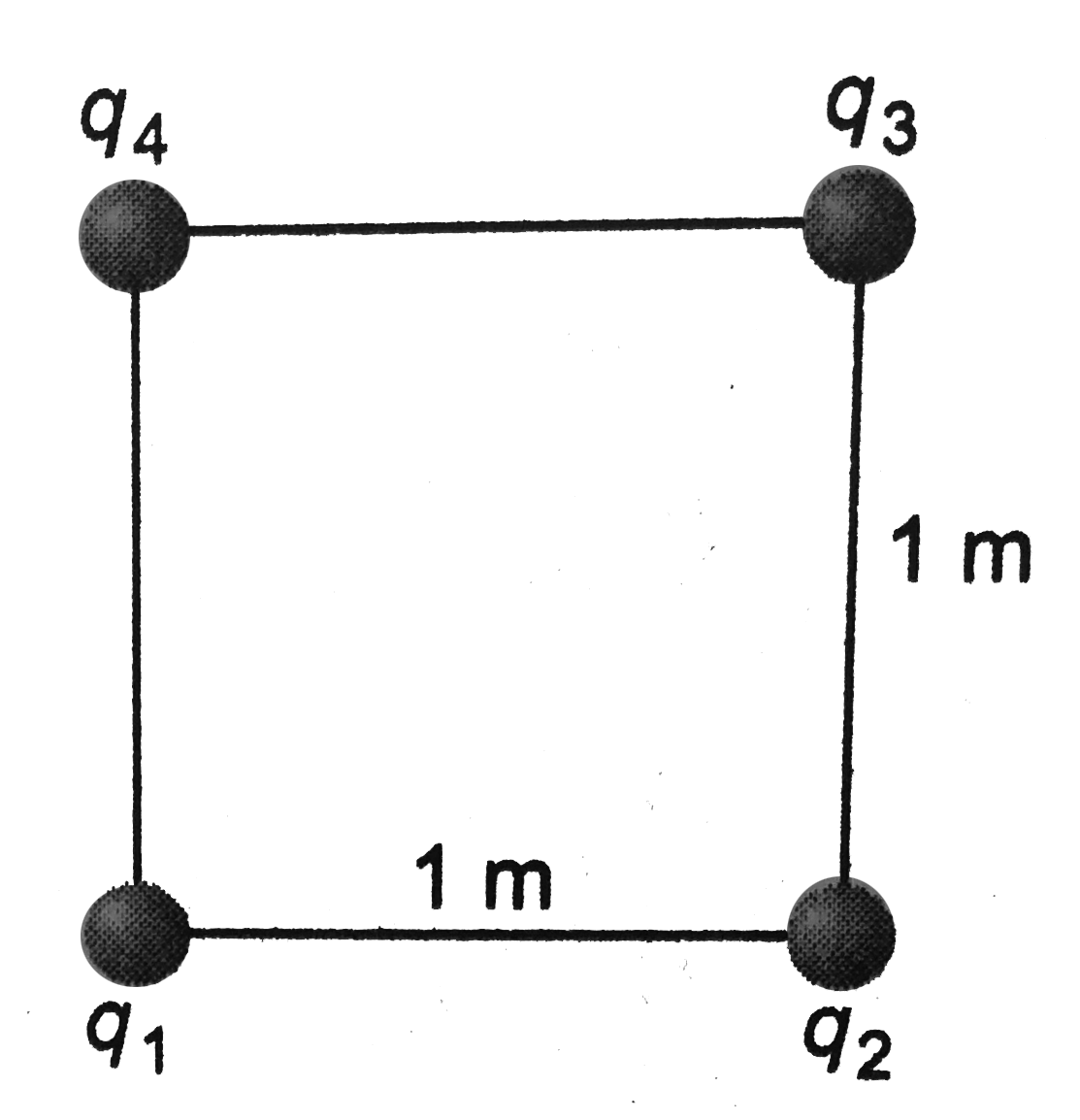 05:04View Solution
05:04View SolutionTwo points charges are located on the x-axis, `q_1=-1muC` at `x=0 and q_2=+1muc` at `x=1m`.
a. Find the work that must be done by an external force to bring a third point charge `q_3=+1muC` from infinity to `x=2m`.
b. Find the total potential energy of the system of three charges.07:42View SolutionTwo point charges `q_1=q_2=2muC` are fixed at `x_1=+3 m` and `x_2=-3m` as shown in figure. A third particle of mass 1 g and charge `q_3=-4muC` is released from rest at `y=4.0m`.Find the speed of the particle as it reaches the origin.
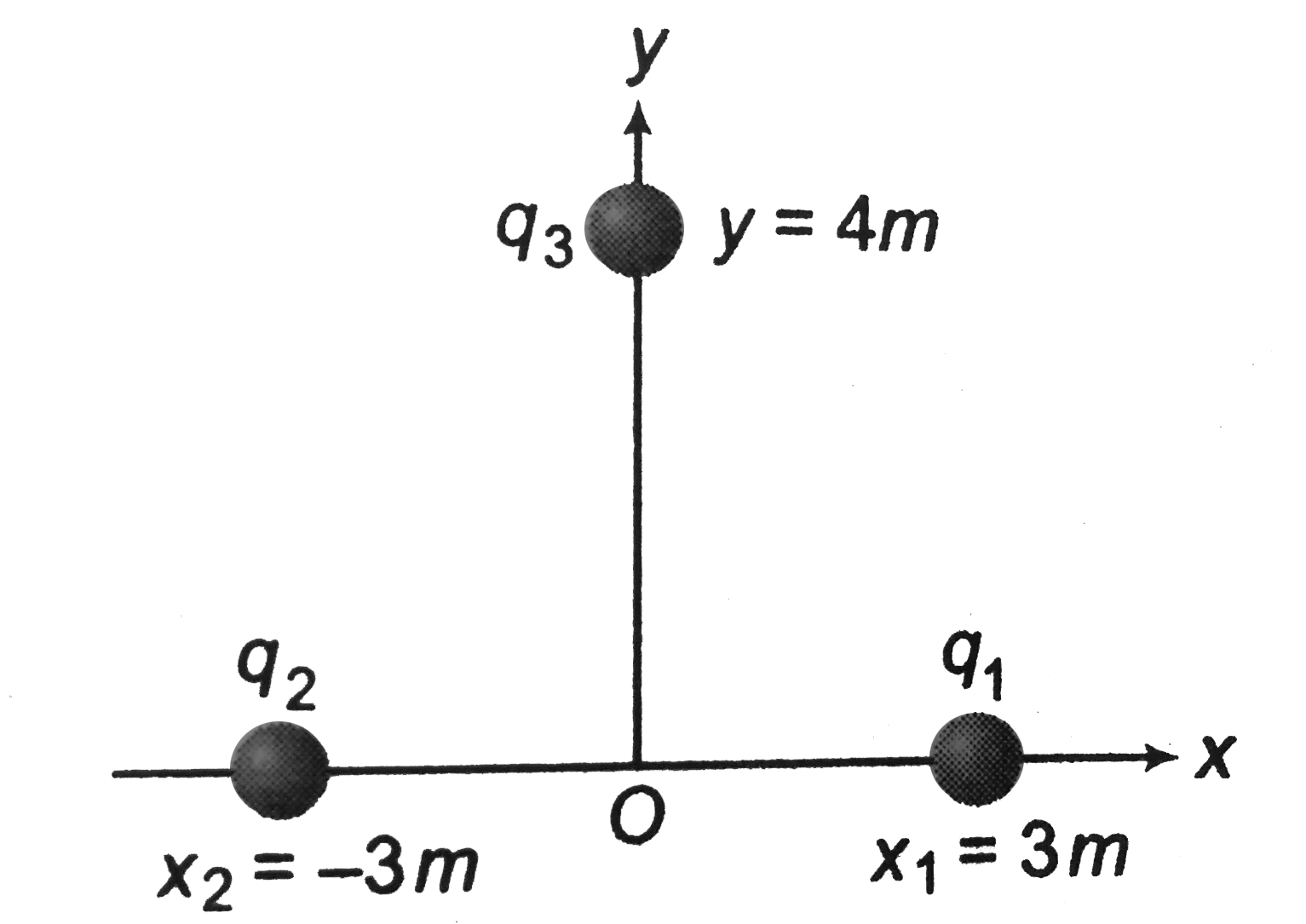 08:14View Solution
08:14View SolutionThe electric potential at point `A` is `20 V` and at `B` is `-40 V`. Find the work done by an external and electrostatic force in moving an electron slowly from B to A.
02:45View SolutionFind the work done by some external force in moving a charge `q=2muC` from infinity to a point where electric potential is `10^4` V.
01:16View SolutionThree point charge `q_1=1muC, q_2=-2muC` and `q_3=3muC` are placed at `(1m, 0,0), (0,2m,0)` and `(0,0,3m)` respectively. Find the electric potential at the origin.
03:54View SolutionA charge `q=10muC` is distributed uniformly over the circumference of a ring of radius 3m placed on x-y placed with its centre art origin. Find the electric potential at a point `P(0,0,4m)`
03:11View SolutionFind out the points on the line joining two charges `+qand -3q`(kept at as distance of `1.0 m`) where electric potential is zero.
04:04View SolutionThe electric potential in a region is represented a `v = 2x + 3y - z`. Obtain expression for electric field strength.
01:31View SolutionThe electric potential V at any point x,y,z (all in metre) in space is given by `V=4x^2` volt. The electric field at the point `(1m, 0, 2m)` is ……………`V/m`.
01:39View SolutionFind the `V_(ab)` in an electric field `E=(2hati+3hatj+4hatk)N/C`, where `r_a=(hati-2hatj+hatk)m` and `r_b=(2hati+hatj-2hatk)m`
02:41View SolutionIn uniform electric field `E=10 N//C`, find
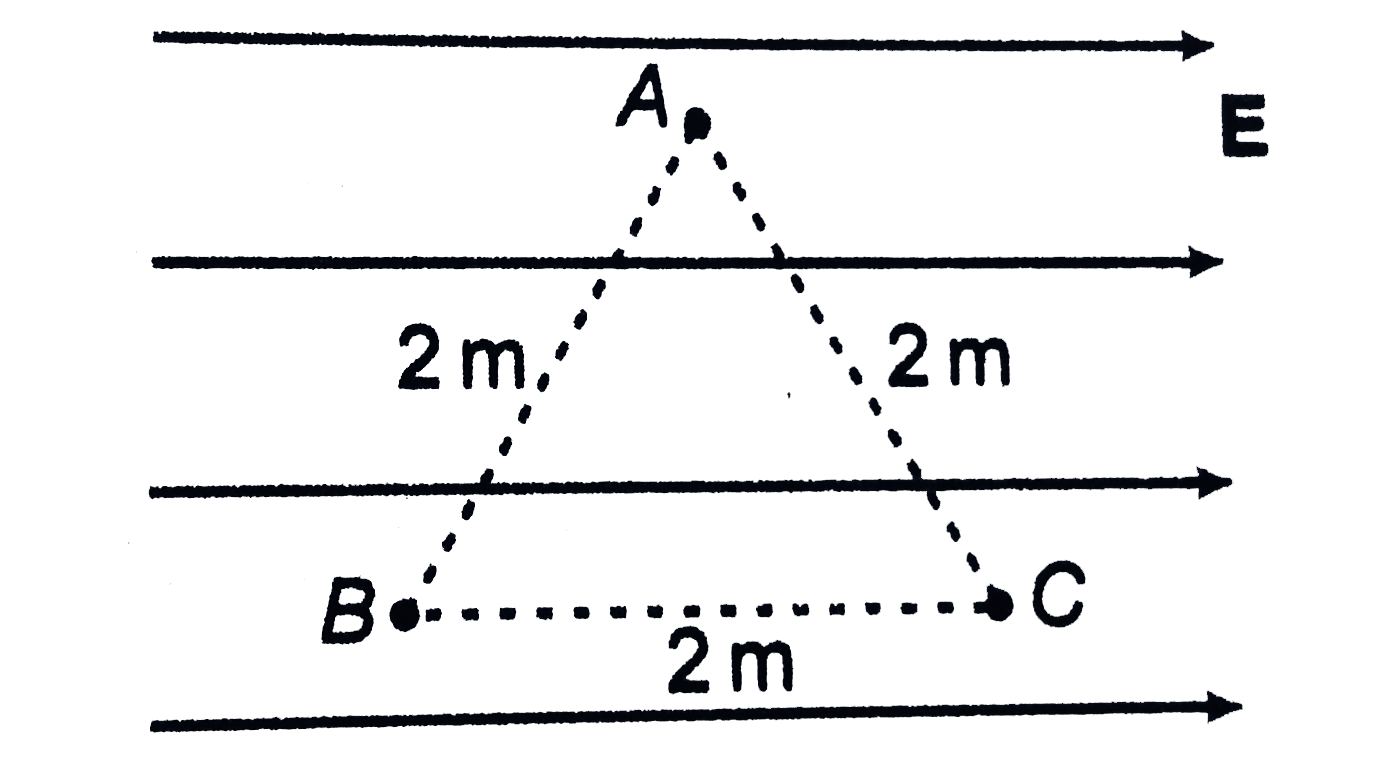
a. `V_A-V_B` , b. `V_B-V_C`04:53View SolutionA uniform electric field of `100 V//m` is directed at `30^@` with the positive x-axis as shown in figure. Find the potential difference `V_(BA)` if `OA=2`m and `OB=4 m.`
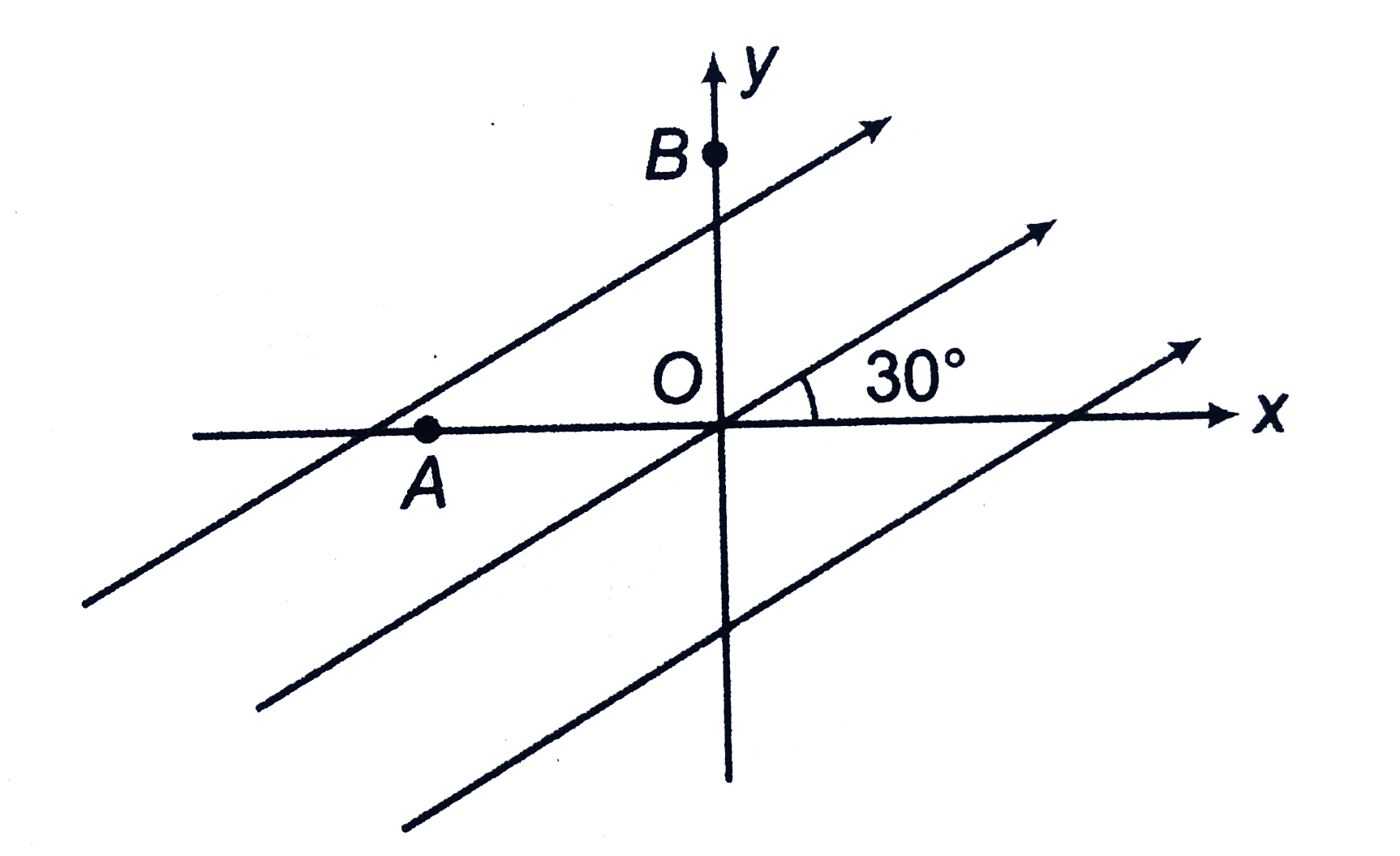 05:33View Solution
05:33View SolutionA uniform electric field pointing in positive x-direction exists in a region. Let A be the origin, B be the point on the x-axis at `x=+1cm ` and C be the point on the y-axis at `y=+1`cm. then the potetial at the points A,B and C satisfy
a. `V_AltV_B`, b. `V_AgtV_B` c. `V_AltV_C` d. `V_AgtV_C`01:38View SolutionA non-conducting ring of radius `0.5 m` carries a total charge of `1.11xx10^(-10)`C distributed non-uniformly on its circumference producing an electric field E everywhere in space. The value of the integral `int_(l=oo)^(l=0)-E.dl (l=0` being centre of the ring) in volt is
02:29View SolutionWhat is the total charge of a system containing five charges `+1, + 2, -3, +4` and `-5` in some arbitrary unit?
01:30View SolutionHow many electrons are there in one coulomb of negative charge?
01:41View SolutionA sphere of lead of mass 10 g has net charge `-25 xx 10^(-9)C`.
(i) Find the number of excess electrons on the sphere.
(ii) How many excess electrons are per lead atom ? Atomic number of lead is 82 and its atomic mass is 207 g/mol.04:43View SolutionA proton and an electron are placed 1.6 cm apart in free speace. Find the magnitude and nature of electrostatic force between them.
02:28View SolutionThe electrostatic force on a small sphere of charege `0.4 muC` due to anther small sphere of charge `-0.8 mu C` in air 0.2 N (i) What is the distance between the two spheres? (ii) What is the force on the second sphere due to the first ?
01:54View SolutionNucleus `._(92)U^(238)` emits `alpha`-particle `(._(2)He^(4))`. `alpha-`particle has atomic number 2 and mass number 4. At any instant `alpha-`particle is at distance of `9 xx 10^(-15)m` from the centre of nucleus of uranium. What is the force on `alpha-`particle at this instant?
`._(92)U^(238) rarr ._(2)He^(4) + ._(90)Th^(234)`02:50View Solution(a) Two identical sphereshaving positive charges are placed `3 m` apart repel each other with a force `8 xx 10^(-3) N`. Now charges are connected by a metallic wire, they begin to repel each other with a force of `9 xx 10^(-3) N`. Find initial charges on the spheres.
(b) Two identical spheres having charges of opposite signare placed `3 m` apart attract other with a force `2.4 xx 10^(-3) N`. Now spheres are touched and then placed at original separation repel with a force `10^(-3) N`. Find initial charges on the spheres.15:43View Solution(a) Two protons are placed at some separation in vacuum. Find the ratio of electric and gravitational force acting between them.
(b) Two point charges are placed at separation `3 m` in vacuum. What can be the minimum force between them.
(c ) A charge `Q` is to be divided on two objects. What should be the value of the charges in the objects so that the force between them is maximum ?
(d) Two insulating small spheres are rubbed against each other and placed `1.6 cm` apart. If they attract each other with a force of `0.9 N`, how many electrons were transferred from one sphere to the other during rubbing ?05:50View SolutionEqual charges each of `20 muC` are placed at `x = 0, 2,4,8,16 cm` on X-axis. Find the force experienced by the charge at `x = 2cm`.
06:06View SolutionFive point charges, each of value +q are placed on five vertices of a regular hexagon of side Lm. What is the magnitude of the force on a point charge of value -q coulomb placed at the centre of the hexagon?
02:19View SolutionThree charges `q_(1) = 1 mu C, q_(2) = -2 muC` and `q_(3) = 3mu C` are placed on the vertices of an equilateral triangle of side 1.0 m. find the net electric force acting on charge `q_(1)`.
How to proceed Charge `q_(2)` will attract charge `q_(1)` (along the line joining them) and charge `q_(3)` will repel charge `q_(1)`. Therefore, two forces will act on `q_(1)`, one due to `q_(2)` and another due to `q_(3)`. Since , the force is a vector quantity both of these force (say `F_(1)` and `F_(2)`) will be added by vector method. Following are two methods of their addition
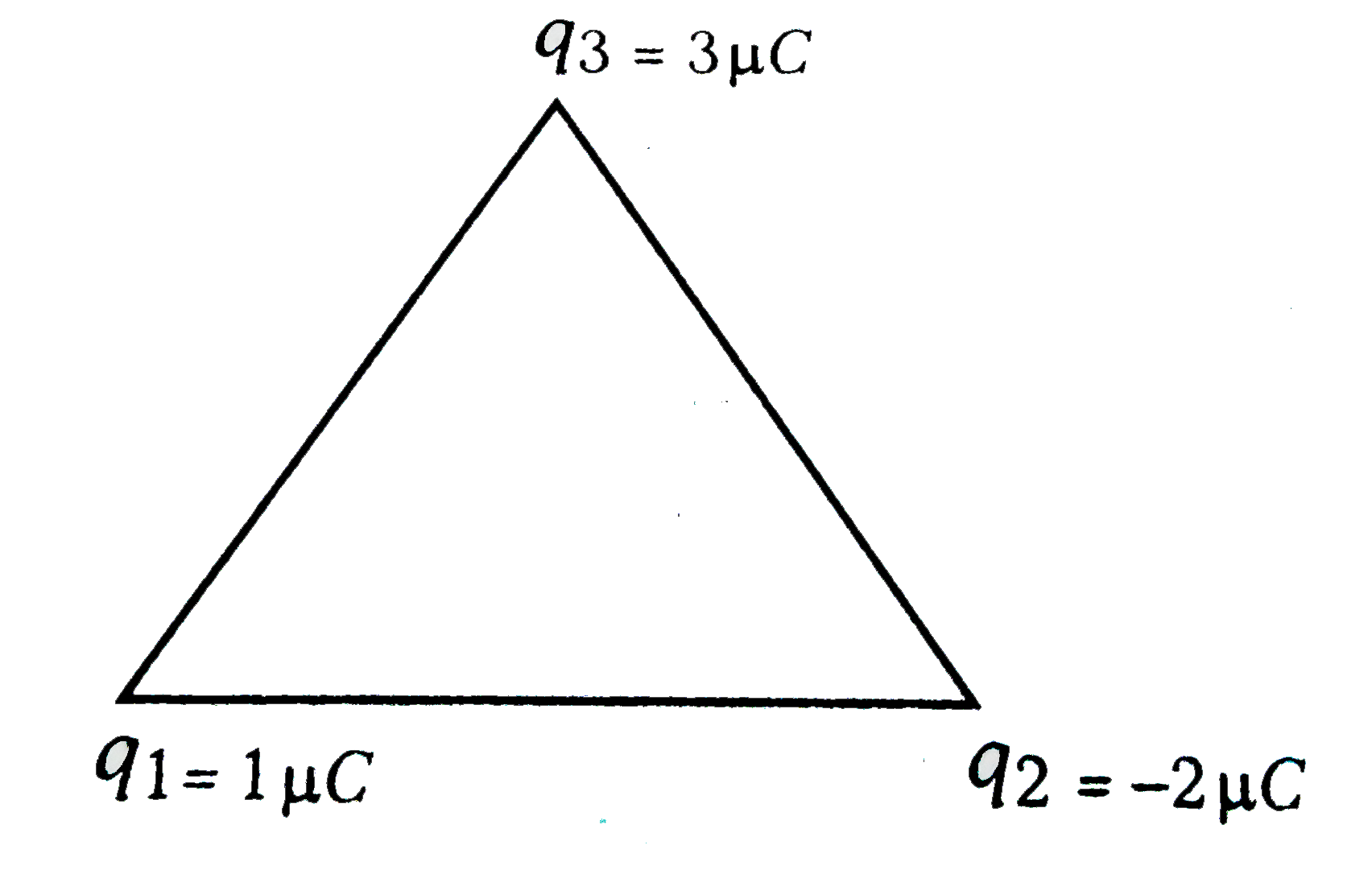 10:46View Solution
10:46View SolutionFour charge `Q, q, Q` and q are kept at the four corners of a square as shown below. What is the relation between Q and q, so that the net force on a charge q is zero ?
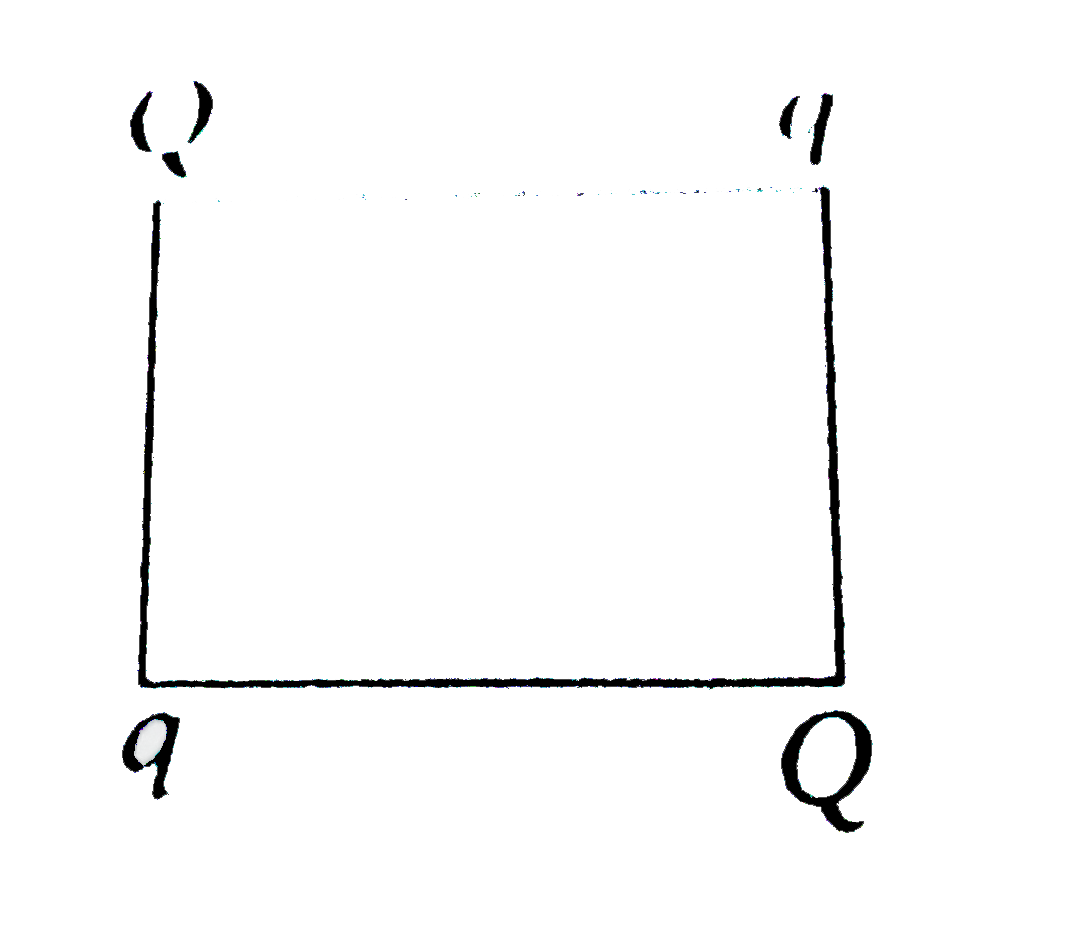 07:31View Solution
07:31View SolutionTwo identical helium filled balloons A and B fastened to a weight of 5 g by threads floats in equilibrium as shown in figure. Calculate the charge on each balloons, assuming that they carry equal charge.
04:27View SolutionTwo indentical pith balls, each carrying charge q, are suspended from a common point by two strings of equal length l. Find the mass of each ball if the angle between the strings is `2theta` in equilibrium.
03:33View SolutionTwo identical balls , each having a charge `q` and mass `m` , are suspended from a common point by two insultating strings each of length `L`. The balls are held at a separation `x` and then released. Find
(a) the electric force on each ball
(b) the component of the resultant force on a ball along and perpendicular to string
(c ) the tension in the string
(d) the acceleration of one of the balls. Consider the situation only for the instant just after the release.05:19View SolutionTwo identical balls each having a density `rho` are suspended from as common point by two insulating strings of equal length. Both the balls have equal mass and charge. In equilibrium each string makes an angle `theta` with vertical. Now, both the balls are immersed in a liquid. As a result the angle `theta` does not change. The density of the liquid is `sigma`. Find the dielectric constant of the liquid.
05:46View SolutionAn electric field of `10^5 N//C` points due west at a certain spot. What are the magnitude and direction of the force that acts on a charge of `+2muC and -5muC` at this spot?
02:55View SolutionCalculate the magnitude of the electric field which can just balance a deuteron of mass `3.2xx10^(-27) kg`
02:25View Solutionfind the electric field strength due to a point charge of `5 muC` at a distance of 80 cm from the charge.
02:30View SolutionTwo positive point charges `q_1=16muC` and `q_2=4muC` are separated in vacuum by a distance of `3.0m`. Find the point on the line between the charges where the net electric field is zero.
03:11View SolutionAs charge `q=1muC` is placed at point `(1m,2m,4m)`. Find the electric field at point `P(0,-4m,3m)`
03:32View SolutionA ball having charge `q` and mass `m` is suspended from a string of length `L` between two parallel plates where a vertical electric field `E` is established . Find the time period of simple pendulum if electric field is directed (a) downward and (b) upward.
04:25View SolutionA ball of mass `m` having a charge `q` is released from rest in a region where a horizontal electric field `E` exists.
(a) Find the resultant force acting on the ball.
(b) Find the trajectory followed by the ball.03:31View SolutionA block of mass `m` having charge `q` is attached to a spring of spring constant `k`. This arrangement is placed in uniform electric field `E` on smooth horizontal surface as shown in the figure. Initially spring is unstretched. Find the extension of spring in equilibrium position and maximum extension of spring.
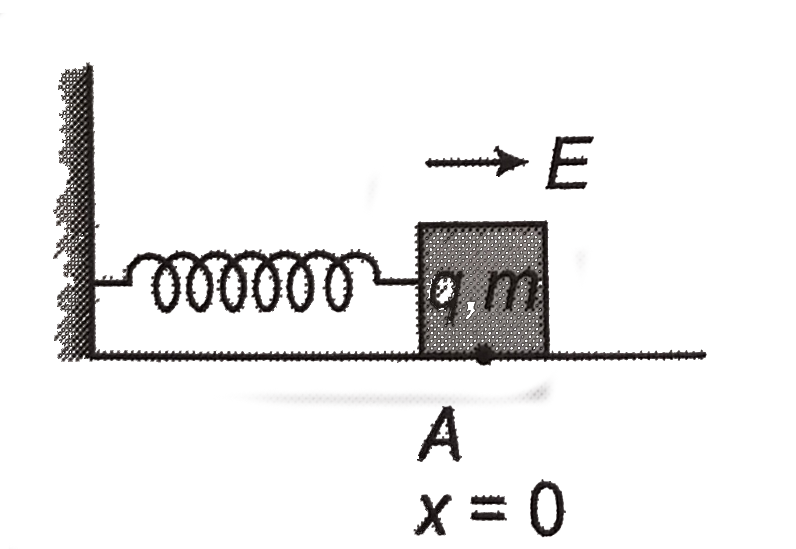 06:22View Solution
06:22View SolutionAn infinite number of charges each equal to q, are placed along the X-axis at `x = 1, x = 2, x = 4, x = 8`,…….. and so on.
(i) find the electric field at a point `x = 0` due to this set up of charges.
(ii) What will be the electric field if the above setup, the consecutive charges have opposite signs.07:49View SolutionFour charges are placed at the corners of a square of side 10 cm as shown in figure. If q is `1 mu C`, then what will be electric field intensity at the centre of the square?
 07:30View Solution
07:30View SolutionWhat charge would be required to electrify a sphere of radius 25 cm, so as to get a surface charge density of `(3)/(pi)Cm^(-2)`?
02:23View SolutionSixty four spherical drops each of radius `2 cm` and carrying `5 C` charge combine to form a bigger drop. Its capacity is.
02:28View SolutionA charge of `4xx10^(-9)C` is distributed uniformly over the circumference of a conducting ring of radius 0.3m. Calculate the field intensity at a point on the axis of the ring at 0.4m from its centre, and also at the centre.
03:17View SolutionCharges `+- 20nC` are separated by `5mm`. Calculate the magnitude and direction of dipole moment.
01:37View SolutionA system has two charges `q_(A)=2.5xx10^(-7) C` and `q_(B)=-2.5xx10^(-7) C` located at points A, `(0, 0, -0.15 m)` and B, `(0, 0, +0.15 m)` respectively. What is the total charge and electric dipole moment of the system?
04:03View SolutionThree charges are placed as shown . Find dipole moment of the arrangements .
(a)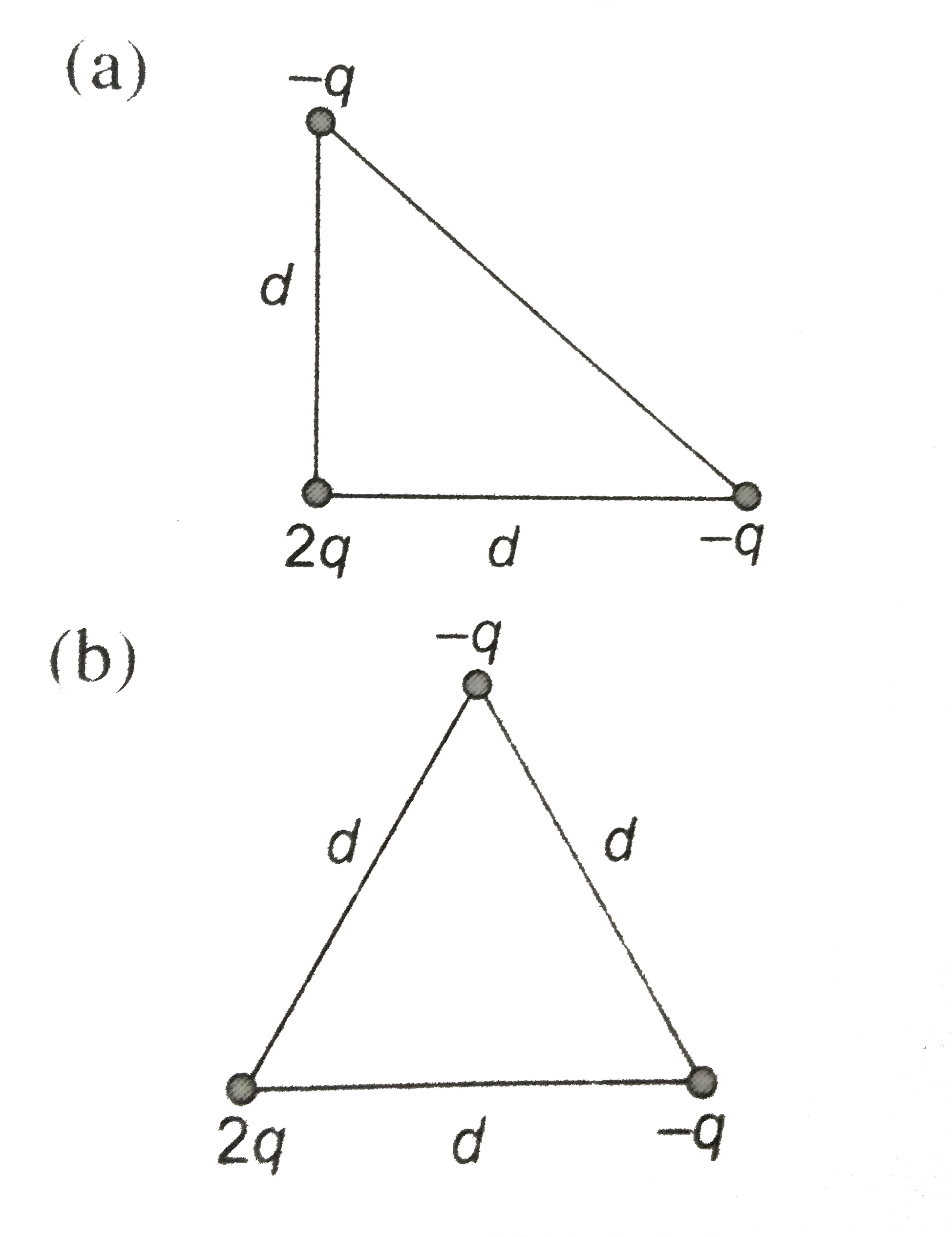 03:26View Solution
03:26View SolutionTwo opposite charges each of magnitude `2 muC` are 1 cm apart. Find electric field at a distance of 5 cm from the min-point on axid line of the dipole. Also, find the field on equatorial line at the same distance from mid-point
02:32View SolutionWhat is the magnitude of electric intensity due to a dipole of moment `2xx10^(-8)C-m` at a point distant `1 m` from the centre of dipole, when line joining the point to the center of dipole makes an angle of `60^(@)` with dipole axis ?
01:49View SolutionAn electric dipole with dipole moment `4xx10^(-9) C m` is aligned at `30^(@)` with the direction of a uniform electric field of magnitude `5xx10^(4) NC^(-1)`. Calculate the magnitude of the torque acting on the dipole .
01:22View SolutionAn electric dipole of dipole moment `p = 5 xx 10^(-18)C - m` is lying along uniform electric field `E = 4 xx 10^(4) NC^(-1)`. Calculate the work done in rotating the dipole by `60^(@)`.
01:47View SolutionThe electric field in a region is given by `E=ahati+bhatj`. Hence as and b are constants. Find the net flux passing through a square area of side `l` parallel to y-z plane.
01:17View SolutionA rectangular surface of sides `10 cm and 15 cm` is palaced inside a uniform electric field fo `25 Vm^(-1)`, such that normal to the surface makes an angle of `60^(@)` with the direction of electric field. Find the flux of electric field through the rectangular surface.
01:48View SolutionThe electric field in a region is given by `vec (E ) = (E_(0))/(a) x hat(i)`. Find the electric flux passing through a cubical volume bounded by the surfaces `x = 0 , x = a , y = 0 , y = a , z = 0` and `z = a`.
04:59View SolutionA cylinder of radius `R` and length `L` is placed in a uniform electric field `E` parallel to the axis. The total flux for the surface of the cylinder is given by
02:13View SolutionA uniformly charged conducting sphere of 2.4m diameter has a surface density of `80.0 mu C//m^(2)`. (a) Find the charge on the sphere (b) What is the total electric flux leaving the surface of the sphere ?
03:11View SolutionA point charge causes an electric flux of `-1.0xx10^(3) N m^(2)//C` to pass through a spherical Gaussian surface of 10.0 cm radius centred on the charge. (a) If the radius of the Gaussian surface were doubled, how much flux would pass through the surface ? (b) What is the is the value of the point charge ?
02:04View SolutionA point charge q is placed at the centre of a cube. What is the flux linked.
a with all the faces of the cube?
b. with each face of the cube?
c. if charge is not at the centre, then what will be the answer of parts a and b ?03:14View SolutionIf a point charge q is placed at one corner of a cube, what is the flux linked with the cube?
02:02View SolutionA hemispherical body of radius R is placed in a uniform electric field E. What is the flux linked with the curved surface if, the field is (a) parallel to the base, (b) perpendicular to the base.
01:56View SolutionAn infinite line charge produces a field of `9xx10^(4) NC` at a distance of `2cm`. Calculate the linear charge density.
01:30View SolutionA long cylindrical wire carries a positive charge of linear density `lambda`. An electron `(-e ,m)` revolves around it in a circular path under the influence of the attractive electrostatic force. Find the speed of the electron.
02:31View SolutionA large plane sheet of charge having surface charge density `5xx10^(-16) Cm^(-2)` lies in XY plane. Find electric flux through a circular area of radius `1cm`. Given normal to the circular area makes an angle of `60^(@)` with Z-axis.
01:52View SolutionTwo large, thin metal plates are parallel and close to each other. On their faces, the plates have surfaces charge densities of opposite sign and of magnitude `.177 xx 10^(-11)` coulomb per square metre. What is electric field
(i) to the left of the plates ?
(ii) to the right of the plates ?
(iii) in between the plates ?01:43View SolutionA thin spherical shell of metal has a radius of `0.25 m` and carries charge of `0.2 mu C`. Calculate the electric intensity at `3.0 m` from the centre of the shell.
01:31View SolutionAt a point `20 cm` from the centre of a uniformly charged dielectric sphere of radius `10 cm`, the electric field is `100 V//m`. The electric field at `3 cm` from the centre of the sphere will be
03:00View SolutionTwo non-conducting sphere of radius R have charge Q uniformly distributed. The centres of sphere are `x = 0` and `x = 3R`. Find the magnitude and direction of the net electric field on the X-axis
(i) `x = 0`
(ii) `x = (R)/(2)`
(iii) `x = (3R)/(2)`
(iv) `x = 4R`05:20View SolutionA non-conducting sphere of radius `R` has a spherical cavity of radius `R//2` as shown. The solid part of the sphere has a uniform volume charge density `rho`. Find the magnitude and direction of electric field at point (a) O and (b) A.
 06:07View Solution
06:07View Solution
Example questions and complete solutions for chapter ELECTROSTATICS of DC PANDEY PHYSICS (HINGLISH) of Class 12
All Exercises from DC PANDEY Class 12 PHYSICS ELECTROSTATICS
- Assertion and Reason
- Check point 1.1
- Check point 1.2
- Check point 1.3
- Check point 1.4
- Check point 1.5
- Example
- Example Type 5
- Example Type 6
- Example Type 8
- Exercise 24.1
- Exercise 24.2
- Exercise 24.3
- Exercise 24.4
- Exercise 24.5
- Exercise 24.6
- Exercise 24.7
- Level 1 Assertion And Reason
- Level 1 Objective
- Level 1 Subjective
- Level 2 Single Correct
- Match the columns
- Medical entrances gallery
- SUBJECTIVE_TYPE
- Taking it together
